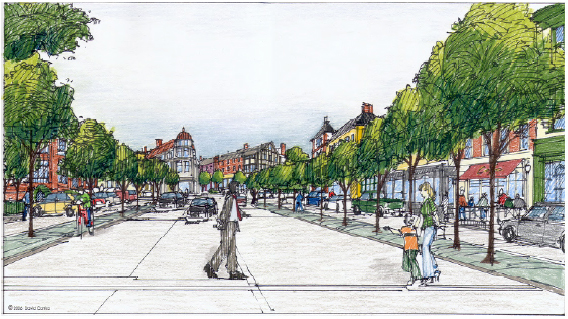New Jersey Future Blog
Incorporating Health Into All Policies
April 1st, 2013 by New Jersey Future staff

Sources: Centers for Disease Control – National Health and Nutrition Examination Survey/U.S. DOT – Federal Highway Administration, Annual Vehicle Distance Traveled in Miles and Related Data
On March 18, Together North Jersey, the regional sustainable planning initiative funded by a grant from the U.S. Dept. of Housing and Urban Development, co-hosted a day-long workshop to introduce the concept of Health in All Policies. Health in All Policies is an approach to policy development that builds consideration of public health impacts into decision-making in a wide range of “non-health” policy areas such as transportation, housing, environment, energy and economic development. It argues that the choices made by non-health decision-makers, whether at the state or local level, within the public or private sector, have tangible impacts on the health of citizens.
Margaret Round, senior environmental analyst with the Massachusetts Department of Health, described an inter-agency working group pilot project in Somerville, Mass., to incorporate health into the transportation planning process using a health impact assessment (HIA). Although there was initial concern about project delays that could result from requiring an HIA, Round explained, “Health impact assessments do not stop projects; HIAs identify the positive aspects of a project and they identify the negative aspects that can then be mitigated.”
Leslie Meehan, director of healthy communities at the Nashville Area Metropolitan Planning Organization (MPO), presented their efforts to update their 2035 Regional Transportation Plan. To direct their work, the Nashville MPO used four guiding principles that they thought would improve quality of life: livability, sustainability, prosperity and diversity. After an extensive stakeholder input process, the MPO executive board endorsed a new direction for future investments made with MPO-managed funds. In general, the new program created a shift away from typical roadway capacity projects toward a more thoughtful approach where “roadway improvement projects that best meet overall goals and objectives for a safe, efficient, multi-modal transportation system will compete for [much] of the funding.” Three other highlighted shifts include:
- 15% to encourage the development of active transportation choices and walkable communities.
- 10% to support other regional investments in public transportation and mass transit.
- 5% to improve the efficiency of the transportation system through innovative management and operations upgrades.
This change in policy direction led to real changes in the way the Nashville MPO transportation dollars were spent, and, among other things, resulted in more sidewalks and bike lanes being incorporated into the transportation network.
One point Meehan underscored was the need for greater active-transportation choices as one way of addressing the country’s rising obesity problem (see graph[ref]Skipper, M. & Leslie Meehan (2012). “Responding to the Call: Incorporating Physical Activity and Health Outcomes in Regional Transportation Planning.” Kinesiology Review, 1, 100 – 106.[/ref], which illustrates the correlation between rising obesity and rising vehicle-miles traveled). The need for increased activity as a way to curb obesity is also underscored in a recent paper published in the journal Circulation, in which researchers from the Anschutz Health and Wellness Center in Aurora, Colorado, concluded that the current obesity strategies of “just eating less” aren’t sufficient. “We are not going to reduce obesity by focusing only on reducing food intake. Without increasing physical activity in the population we are simply promoting unsustainable levels of food restriction. This strategy hasn’t worked so far and it is not likely to work in the future.”
Among the recommendations to encourage activity documented in a new report published by the Institute of Medicine of the National Academy of Sciences, titled Accelerating Progress in Obesity Prevention, is a focus on the built environment. “Communities, organizations, community planners, and public health professionals should encourage physical activity by enhancing the physical and built environment, rethinking community design, and ensuring access to places for such activity.” The Nashville MPO and Massachusetts examples demonstrate the benefits of multi-sector approaches to addressing obesity, and can serve as models for New Jersey. The Health in All Policies workshop was a starting point to highlight ways we can build capacity in our region. One excellent place to begin doing this is in Together North Jersey’s three local grant programs: the Local Demonstration Project Program, the Community Organization Micro-Grant Program, and the Local Government Capacity Grant Program. Local governments or organizations should be encouraged to submit proposals for these grants that focus on ways to incorporate health into local policies, so that templates may be developed to help other organizations do the same.
















